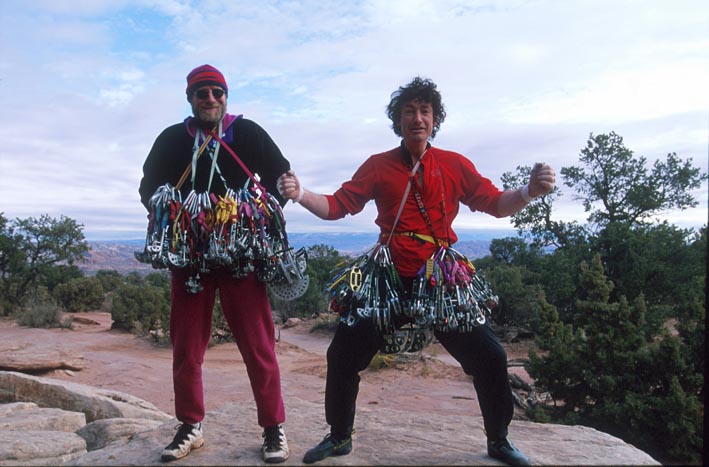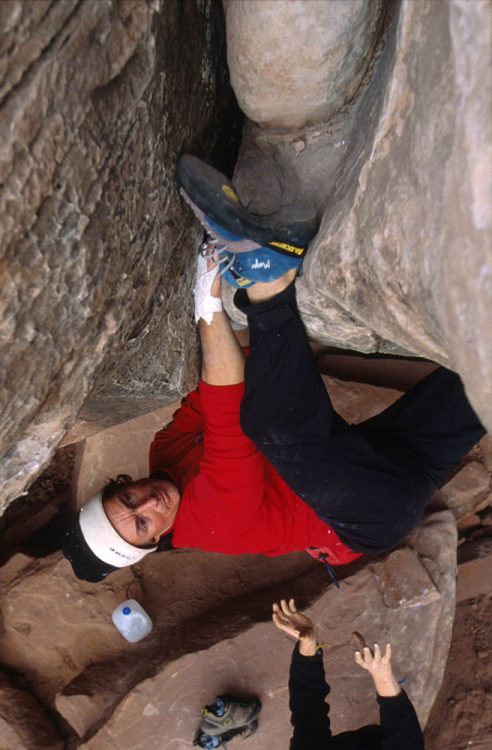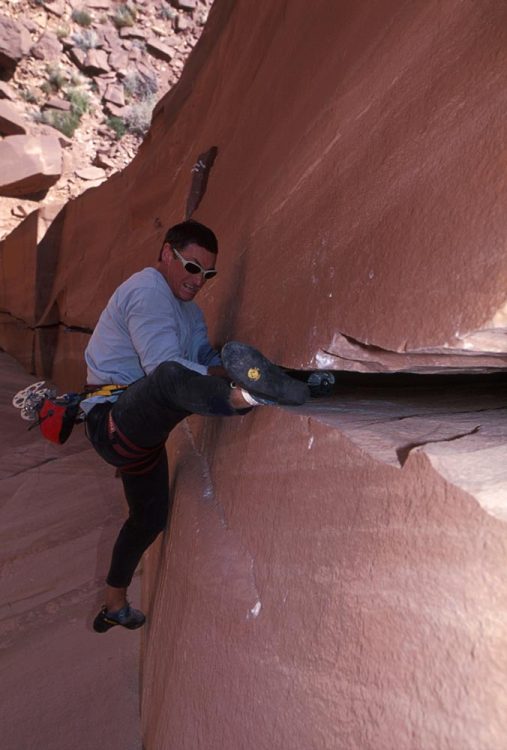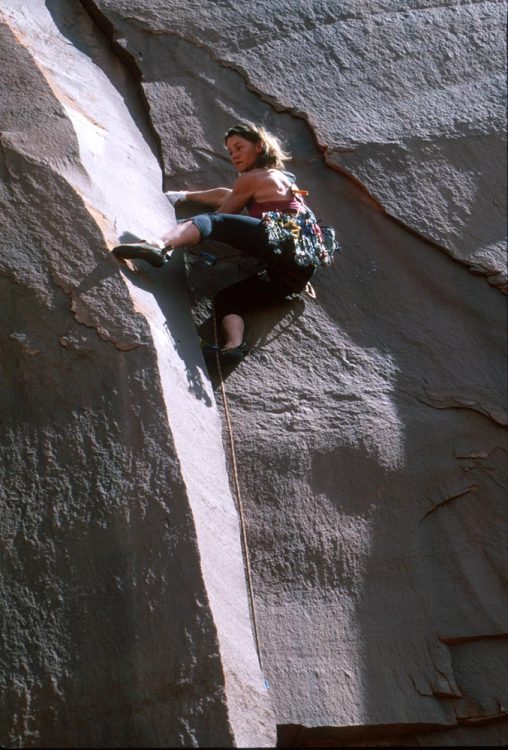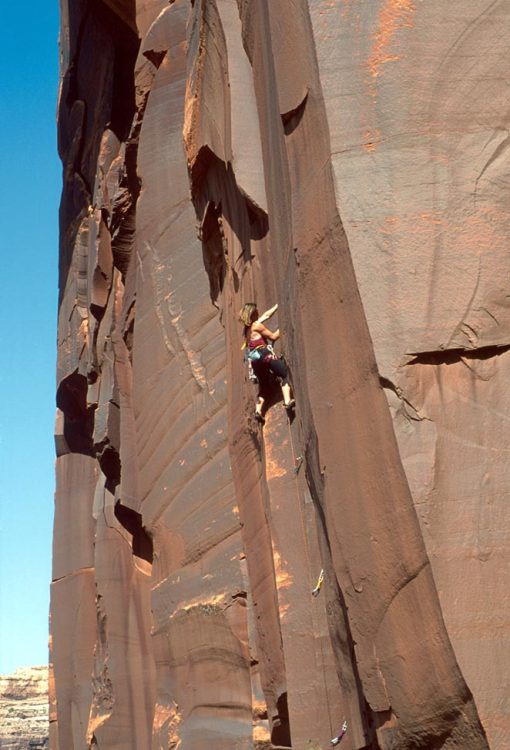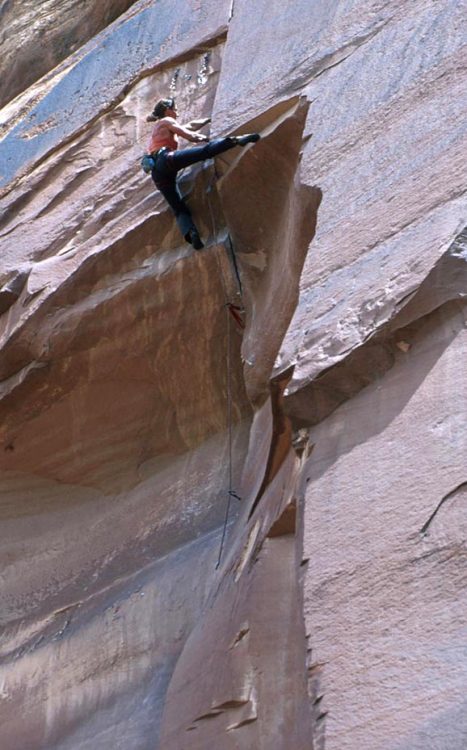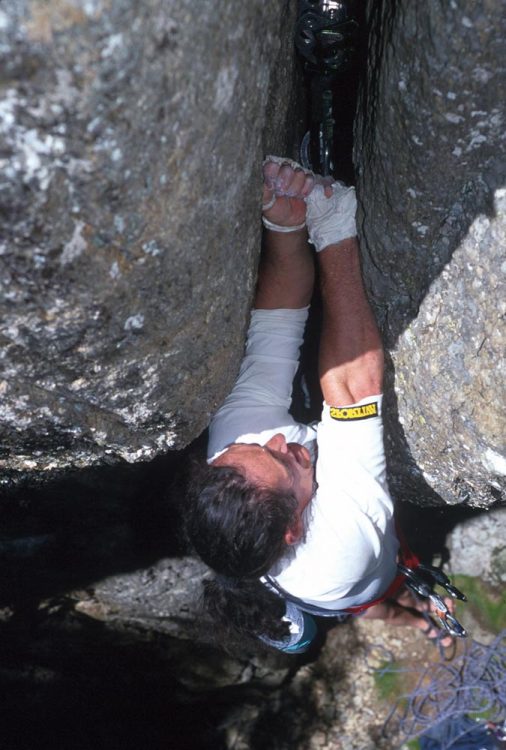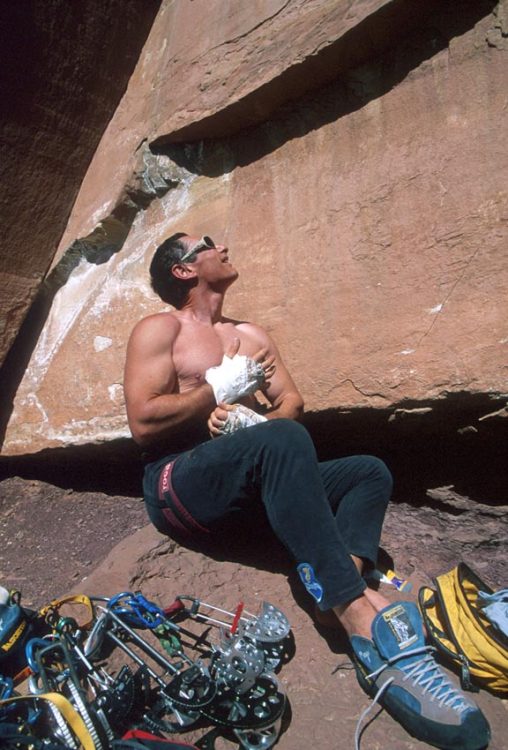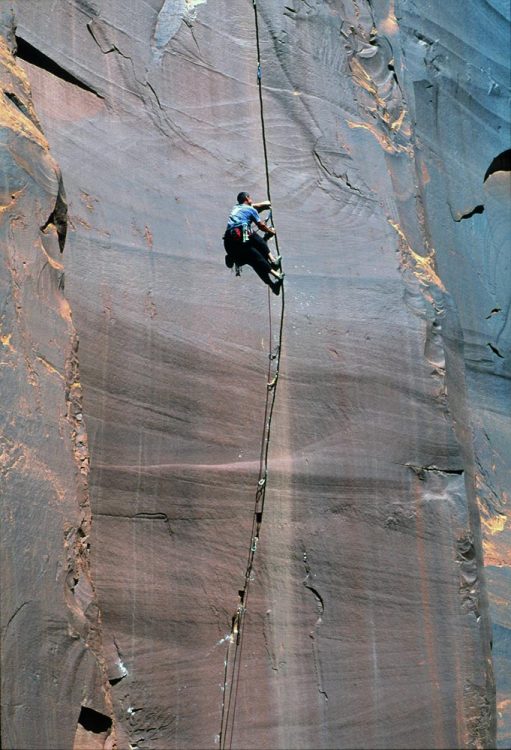Cracks come in all shapes and sizes from those so thin that you can hardly hammer anything into them, to huge chimneys that you can only climb out of by pushing yourself with your whole body. But since climbers also come in different sizes, the art of crack climbing depends entirely on the correspondence of these parameters.
Cracks are rated for the average climber with average fingers, hands, fists, knees and feet, if he climbs them, of course. But even when he climbs them, he will still have problems with certain sizes (everyone has problems with them), namely “bigger than a finger” and “bigger than a fist”. “Bigger than a finger” is a real nightmare, but “bigger than a fist” or off-width is reserved for guys too lazy to read guides or perverts. If you could, you would only climb cracks that are ideal for you in size, but then you would miss, in my opinion, the most interesting crack routes – those that, expanding and narrowing, make everyone suffer well.
The rules of the game are generally the same – transfer the weight to your feet, climb smoothly, rest. Do not wedges fanatically – your task is to climb, not to widen the crack. Do not forget about the holds on the wall, they are extremely important both for climbing and for rest, which is necessary for the hands when climbing a crack. It is necessary to wrap your hands with a bandage – it protects against various cuts and injuries to the skin of the hands, so if you do not want to show off cool scars after a day on the rocks, you will have to try and wrap your hands well. If the crack is a finger wide – wrap the second phalanx, a crack under the arm – carefully wrap the back of the hand, leaving the palm itself free, for cracks under the fist do not forget to wrap the thumb and the side of the hand, and for offwidth – the whole body except the eyes. Also, a second pair of climbing shoes will not hurt – more spacious and with good ankle support. If you are climbing a thin crack – try to climb it in thin climbing shoes. The following technique works well on inclined cracks: a thin climbing shoe is put on the leg that is working in the crack, and a hard climbing shoe is put on the other leg, so that you can stand on the wall with it.
Micro-cracks
If the rock is even slightly inclined, then you still have a chance, otherwise – forget it. If you can’t get your finger into the crack, then the only option is to climb in a tilt from the edge of the crack, pushing off with your feet. Curved sports climbing shoes are good for this, preferably new ones. Another option is to simultaneously push your thumb into the opposite part of the crack. Experiment with your thumb – this can be the key. In small widenings of thin cracks, you can wedge your fingertips or little finger. Of course, you can easily damage your joints, but in fact, even the little finger is a very strong finger, look at Edlinger and Güllich – both could pull themselves up on one little finger. I’ll say right away – sometimes it’s better to pretend to be sick than to climb a crack on your fingertips or climb Lynn Hill. In general, it is harder for guys, take, for example, Lune de Miel, 8b, Chamonix, or the “Nose” of El Capitan, although some individuals have thin fingers. In such cracks, thin stoppers and mini-cams work great.
The best option is when the crack fits your fingers without problems. If the crack widens, then turn your palm with the thumb down and spread your fingers. In such cracks, rock shoes work great, and friends from 1/2 to 1 size are usually put. The perfect example is Sans liberte Chamonix, 8b/b+, a difficult route, but undoubtedly the best. Cosmic Debris in Yosemite is a great 8a, and one of the best cracks is Sphinx Crack in Colorado, 8a+. Don’t forget about the headwall on “Salathe” – a perfect crack in a perfect place. Another classic “nightmare” is the No Way Josh route, 8b – an overhanging crack for fat fingers (that’s where they come in handy), will anyone else climb this route clean? Friends #1-1.5 go there.
More than a finger
On average, this size corresponds to friends from 1.5 to 2 sizes, and this means big problems. Fortunately, such cracks are few, and all of them are in the desert in the States. You have to be a cool climber to climb them to climb, and to stop and lay down, you need the hands of a blacksmith. Such cracks are not made for onsight, I generally consider them a perversion, and, thank God, they are not in France, Germany, or Italy. If you can’t climb in a tilt, then you can try the off fingers technique. Place your palm in the crack, thumb down, squeeze all your fingers at once, loading your hand. In this case, you can only stand up normally when both hands are in the crack, but to move one hand, you need to work your legs – it looks like a series of short jerky movements with your leg to slightly move your hand.
As soon as the crack gets wider, you can fold your fingers into a “lock”. This is how it is done: rest the tip of your thumb on the edge of the crack, press on the thumb with the rest of your fingers, pushing it into the crack. Most will say that without a patch it is painful and impossible. With a patch it is a little less painful, which means it is possible. Another variation of the finger lock is to push two fingers horizontally into the crack, forming a hook or ring. This can be useful in shallow cracks. Sometimes the index and middle fingers work well, and sometimes the middle and ring fingers, but the lock is very difficult to hold if there is no narrowing of the crack nearby. Another option for the desperate is to push the palm deeper into the crack, tearing the skin off the palm, this can be done a couple of times, but not on steep sections. The best example of cracks “bigger than a finger” is the route Tricks are for kids, 8a, 50 meters of parallel crack in Canyon lands, USA. You will need fifteen friends #1–1.5, and here it is better to be a girl (in terms of fingers).
Arm-in-arm
One of the most pleasant pleasures in life, along with French cheese, German beer, Colombian cocaine and Italian motorcycles. If you are strong, it is difficult to fall off such a crack, and, say, in Britain you will get a great advantage on the ledges, hanging on one hand, yawning and snoring before climbing further. But thin cracks for the hand are not so easy and pleasant, especially on an overhang. If you can’t squeeze your thumb inside the palm, then you will quickly get tired. The only way to “break” your hands is to alternate grips: thumb up or down, or try to wiggle your thumb until you look like Popeye the Sailor (a comic book and cartoon character created by cartoonist Elzie Chrysler Segar – ed.) – then it is better to forget and fly off. In suitable cracks everything is possible, because every movement is reliable, and the legs can work well, wedge them in cracks, and if the terrain allows – throw them above your head, you will have a third hand, which will not be a hindrance on sharply protruding sections. Excellent examples of routes: Ma Dalton, 7b+ and Panoramix, Chamonix, Separate reality, USA, Mandarin Merveilleux 6c+, Verdon. Friends #2 for thin cracks and #2.5–3 for good ones.
Under the fist
I heard from experts that it is this size of cracks that are relatively easy to climb, but if you are a beginner, or slightly out of shape, you can get injured. Palms, unlike a fist, cover much larger gaps, but a fist has a limited area of use and requires a lot of strength. In such gaps, your best friends are your legs and friends #3.5–4. After the gaps under the arm, the first fist placed in the gap will look very smeared. You just push yourself, inserting your palm into the gap and squeezing it. You don’t need to put your fist too vertically – it will be uncomfortable to get up, but you don’t need to put it “on the break” – the whole arm will get clogged very quickly. If the gap widens, then boxer’s fists will not interfere, but if it widens further, then you will have to add a knuckle of the thumb to the fist. This is very painful, unreliable, and it is better to wrap everything with a band-aid. A big plus,that in such cracks you can rest, placing your fist above your head on your outstretched arm. Another option for maniacs is to rest the knuckles of the first phalanx of the fingers against one wall of the crack, and the tips of the fingers and thumb against the other, sometimes this helps, but I did not have much success with this grip. Also, in cracks under the fist, rock shoes are very important, sometimes it is even better to wear larger ones – they can compensate for insufficiently large fists. And since it is much scarier to get into cracks under your fist, you will lie down more often, which means taking more iron, carrying additional weight.
Fist-width, or “offwidth”
The pleasure this size gives to all dedicated, brave and tenacious climbers who suffer from constant ridicule from the public is indescribable. But the disdain of the unenlightened masses is only a consequence of the lack of understanding of this art, comparable to wrestling in the mud or transporting a double bass on the Paris subway at rush hour. There are two techniques for offwid: the good old spreading of the arms and the more modern technique of jamming the arms. Fortunately, you can now get excellent friends #4.5-5. Long ago, when there were no good nuts, many climbers broke or even killed themselves on simple offwidths.
Breathing with hands
Easy to explain, hard to do. The hand is inserted into the crack, resting against it with the palm on one side and the elbow and triceps on the other, thus wedging. Together with the hand in the crack is the leg of the same name. The other leg finds a good hold, with the other hand at this time hold on to the edge of the crack in the direction opposite from the hand in the crack. In such moments, it is very easy to release all your strength in microseconds, thanks to the release of adrenaline, especially if the extreme point is far below, so take a normal number of friends with you. If you are completely exhausted, then it should be easy to go down, especially on inclined cracks, but I would not advise you to do this. Eau et Gaz in Chamonix is a scary 7c that requires constant hand-splitting. Any pitch on Texas Tower in Utah. And my personal favorite, Dream Speaker Tower, where no one will hear you scream except the desert spirits.
Hand Jamming
Hard to explain and hard to do. Sometimes called “Leavittation” after one of its creators, Randy Leavitt. Leavitt and Tony Yaniro achieved success with this difficult technique on the cement walls of California parking lots. This city is still the best place to find such cracks. The first route to use “Leavittation” was the overhanging Piaspano, which had already been climbed by one of Yosemite’s best climbers, John Long. Long wasn’t just a big guy, he had huge hands, which he also put on gloves and covered with plenty of tape. But since Leavitt and Yaniro were smaller, they couldn’t do it until they had mastered “leavittating.”
Hand + Hand
Can be used in fist gaps and wider. Cross your hands so that the backs of your palms rest against each other, your palms rest against the gap, and your hands are wedged apart by each other. Depending on the size of the crack, the hands can be shifted relative to each other.
Hand + fist
The same as in the previous case, but the second hand is folded into a fist.
Fist + fist
It is better to cross the arms, although this is still very unreliable and unstable, and try to uncross the arm. A great example is Thai Boxing, 7c, Chamonix Valley, Le Buet. All kinds of hand placements will help you on this beautiful overhanging crack, which was first climbed by Craig Lubben himself, one of the great masters of wide cracks. Other examples are Trench War fare in the USA, 7c+, heavy and painful Belly full of bad berries with a 9-meter cornice in Indan Creek, USA.
Most people are afraid to climb wide cracks. Fear is the enemy of technology, so it has no place in cracks, it is much more appropriate on dangerous mirrors. A particularly strong wave of fear rolls in when a foot slips, so it is important to place your feet correctly. Although spread arms are very reliable, moveIt is very difficult to climb them up. Another great option is to wedge your knee in the crack. And if the crack is even wider, you can use your thighs, and even wider – even your thigh. It all depends on your imagination and experience, do not forget to wear long pants, wrap your knees with tape, or better yet, wear thin knee pads. If you have never done anything like this, it is better to climb with top belay.
In cracks wider than an open arm, the “chicken wing” technique is used. This is usually very reliable, but changing hands is a real problem. The elbows are higher than the palms, and the hand is pressed into the opposite wall of the crack, and the triceps create the moment necessary for wedging. Just like a tricam. Sometimes, when you are deep in the crack, you can make a “chicken wing” with your second hand, with your palm slightly below the elbow of the first hand, in this position it is convenient to move your legs. The feet in a wide crack are usually in a “frog” position, but you have to stay calm and think about how to place your feet – they can give you a big advantage. Great examples are Lightening bolt cracks on North Six Shooter Tower and Thelma and Louise on Organ Tower, Utah, but almost every tower in America has short sections of wide cracks, which is why each tower leaves such vivid memories, like scars on the brain. Bad Ass Woman in Yosemite is a great short offwidth to practice on, if you successfully climb it more than once, try climbing El Capitan, or seek medical help.
A little about belay
If you want to learn to love cracks, you simply must go to the USA. Yosemite is probably the best place to learn, and in good granite belaying is easy and reliable. If you become obsessed and love towers, then the desert is your place: it will give you everything you could want and more. Prepare yourself for beautiful sunsets, solitude, shattered rocks and sand that will turn your friends into useless pieces of aluminum and your brain into caramel. In Wyoming, there is an area called Vedavoo, the best collection of offwids and home to master climbers with huge fists and small knees… Generally, cracks require a lot of friends, but offwids require even more, so it is better to gather gear from all of them. In unpunched cracks, your work will be much more difficult, and although placing friends seems easy, it takes time.
Putting dots in a crack is no easier than putting in the crack yourself, and doing it well can take a lot of time. That’s why many people think that top rope crack climbing is at least a grade easier than leading them, so don’t be fooled. In some rock areas in the US, all the gear goes into a route, while in other areas, and in the world in general, the traditions are much softer. And a bunch of friends also weighs a lot – that’s why these Americans are so big. Friends come in different sizes, different prices… I don’t have personal preferences, there are wide friends for soft rocks, there are very light models, friends with narrow cheeks – you need to choose friends from a good manufacturer. You are unlikely to need many size 3 friends: this is the easiest size for climbing. Unscrewing tubes are a great choice for offwidth, but they are difficult to use. The advantages are huge overlap, and, if necessary, you can stand on them. For thin cracks you need thin fingers, like Lynn Hill, so a strong woman in the team is even better than a lot of iron.
In thin cracks you use micro-stoppers, mini-cams, and on limestone it is better to put them close to each other, but do not put them too often – on cracks, leaving all the iron at the bottom is the same as leaving all your strength there.
And also, Yuji Hirayama and his ascent of “Salathe” is something! Lynn Hill’s one-day free ascent of The Nose is probably the best one-day climb ever.
A few crack routes in Chamonix that I can recommend:
Pilier Cordier on Grand Charmeaux, difficulty 5+/6 650 meters of excellent cracks. Not very difficult, good for a warm-up.
American Direct on Petit Dru, 1100 meters. Classic. Difficulty up to 6c, does not require any special skills, very memorable.
Directissime Americaine – wide cracks, difficult to do in a day, aid in two places, difficulty up to 7a+, Petit Dru.
Directe des Capucines – difficulty up to 6c, bizarre wide cracks, the last pitches are along the Bonatti route, a true classic, even better than Astroman, Gran Capucin.
Echo Des Alpages – some beautiful overhanging cracks, great offwidth, a bit of everything. A must.
US crack routes:
Pink flamingo, 8a/a+ fingers and all. Indian Creek, a must.
The wide cracks of Texas Tower in a remote part of the desert, where no one will see you cry!
Salathe, a great Japanese and German route, all sorts of cracks.
Free Rider, the so-called “light Salathe”, without the last 8a crack, but with one more offwid.
Lurking Fear on El Cap. The cracks are cool, but the sections on the wall and off-views are truly nightmarish.
Photo: Stevie Haston archive
Source: alp.org.ua

